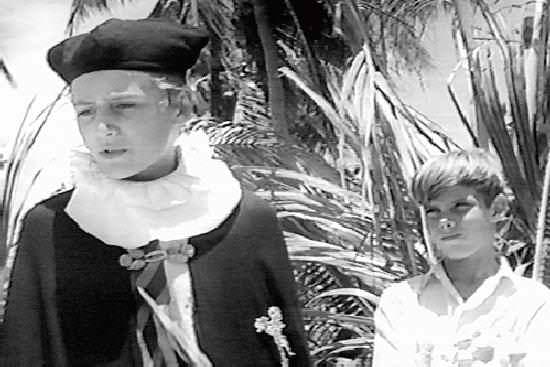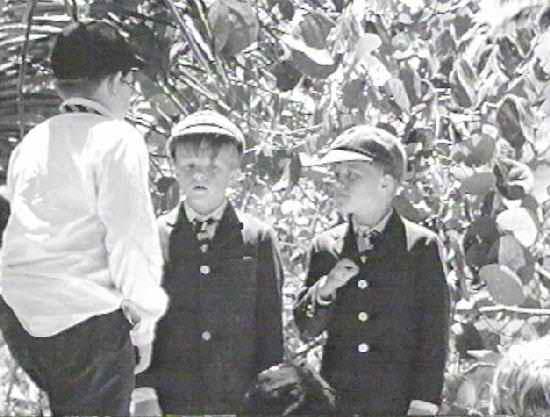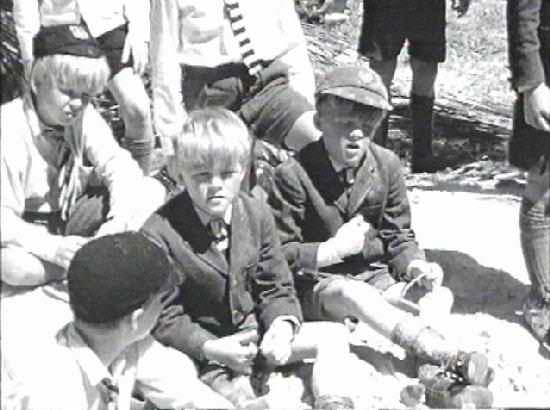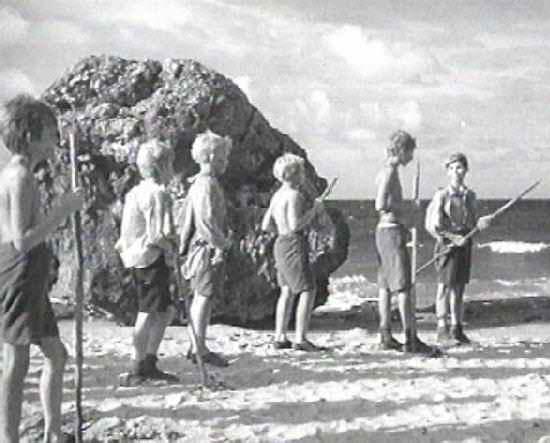
Figure 1.--The boys in "Lord" of the Flies" at the beginning of the film are depicted in their school and choir uniforms before they begin the descent into barbarity. The head choir boy Jack battles Ralph for supremacy.


Figure 1.--The boys in "Lord" of the Flies" at the beginning of the film are depicted in their school and choir uniforms before they begin the descent into barbarity. The head choir boy Jack battles Ralph for supremacy. |
This is surely one of the most provocative films about boys ever made. It is in the same genre as The War of the Buttons, but much more powerful. This is a very powerful and dramatic movie. The acting by the boys is excellent, the writing is effective, and the location shooting is superb. The plot is about a group of English private prearatory school boys, including a choir, stranded on a deserted island when the airplane they are on crashes. All of the adults are killed and except for the very end, adults play no part in the plot and do not appaer. The film is based on the acclaimed novel by Sir William Golding and the film lives up to the book--unusual nowadays. Some of the boys attempt to resist the descent to barbarity, but the boys slowly revert to the primitive--led in this case by the choir. With many kids surviving, but no adults Ralph (James Aubrey) initially takes charge to the dismay of Jack (Tom Chapin), who wanted to be the leader. Eventually, Jack has enough of Raplhs leadership methods (order, discipline, rules etc), and decides to go it alone. Soon most of the kids have gone to Jacks "evil" camp. Without any adults in the party, civilization soon disapears as Jack imposes his rule leading to the theft, torture, and murder. It doesnt take long for these well behaved kids to turn into savages, that are capable of anything. Most of the boys wear English short pants school uniforms at the beginning of the film, including caps, ties, blazers, short trousers, and kneesocks. They slowly discard their hot woolen clothes. Mostly non professional actors were used for the boys who had a real romp on the island during the filming. James Aubrey, Tom Chapin, Hugh Edwards, Tom Gaman.
This is surely one of the most provocative films about boys ever made. It is in the same genre as The War of the Buttons, but much more powerful. This is a very powerful and dramatic movie. The acting by the boys is excellent, the writing is effective, and the location shooting is superb. The film was a low-budget shoot by the British studio Criterion. The fiom was directed by Peter Brooks and produced by Lewis Allen. Brooks worked with an amateur cast and a small crew, but managed to fashion a small, but stunning masterpiece. The black-and-white images by the camera crew are stunning and perfectly capture the feel of the Golding novel. The boys, perhaps because they were not child actors, perform briliantly. There is not feel in fact that they are actually acting. The director during the filming had two cameras running most of the time. The director concentrated on the first camera. The second cameraman was allowed to roam around filming whatever appealed to him. This informal, candid experiment gives the film a documentary feel.

Figure 2.--Piggy and the Twins are seen here early in the film before their school uniforms begin to disappear. |
William Golding's best known novel is the Lord of the Flies. The book is about a group of English shoolboys marooned on a deserted island. The plot chronicles their desent into barbarity. The author is suggesting that only a thin veneer of civilization masks the ionner savagery of human beings. There are considerable references to clothing in the book, especislly in the early pages when the children are first marooned on the islasnd. Golding describes the English school uniforms and the chorister uniforms in detail. The 1960s film version film follows the book costume descriptions closely.
The book is of course a fictional examination of the nature of man. Rosseau and others have argued that man is at hear good--the nobel savage--and is corupted by society. Hobbs, Lock and others have argued that man is savage by nature and nust be restrained by society. Golding in Lord of the Flies presents his view that only a narrow venner of civilization covers our trur barbaric nature. The book is an excellent way of exploring this question with school children. One that veneer is removed, man quickly descends to barbarity. The characters, plot, and even secenes and props used in the film are finely defined in Golding's book which the film follows closely within the limits of time allowed by a movie production.
Mostly non professional actors were used for the boys who had a real romp on the island during the filming. James Aubrey, Tom Chapin, Hugh Edwards, and Tom Gaman.
The plot is about a group of English private prearatory school boys, including a choir, being evacuated out of fear of a nuclear war. When the plane they are on crashed, they are left stranded on a deserted island. Conveniently for the plot, all of the adults are killed and except for the very end, adults play no part in the plot and do not appaer. Some of the boys attempt to resist the descent to barbarity, but the boys slowly revert to the primitive--led in this case by the choir. With many kids surviving, but no adults Ralph (James Aubrey) initially takes charge to the dismay of Jack (Tom Chapin), who wanted to be the leader. Eventually, Jack who is obsessed with hunting has enough of Raplh's leadership methods (order, discipline, rules etc) and focus on maintaining a signal fire. Ralph and his hapless follower Piggy believes in society as they know it now far away. Jack believes in hunting, and survival of the fittest--in essence war. Jack decides to break away from Ralph. Soon to Ralph and Piggy's dismay, more and more of the boys have gone over to Jacks hunting camp. Without any adults in the party, civilization soon disapears as Jack imposes his rule leading to the theft, torture, and murder. It doesnt take long for these well behaved kids to turn into savages, that are capable of anything.

Figure 3.--The boys prep school uniforms from caps to blazers soon are discarded in the heat and dirt of a deserted tropical island--the process is a metaphor for their rapidly discarding the strictures of civilized behavior. The choir robes and preparatory school uniforms also serve to highlight the "angelic" innosence of the boys before the barborous nature only a little below the surface in most of us begins to emerge. |
The plot swirls around the conflict betwwn the two leaders, Ralph and Jack representing civilization and barabrity. The tragic Piggy is a charcter that most school children will instantly recognize, a boy who is academically bright, but totaly incapable of holding his own with his peers. The twins perhaps symbolize innonscence lost. Then there is Simon. Hwe enjoys long walks by himself into the jungle while the other boys play. He is the one who discovers "the beast" that the boys have come to fear. He discovers the true source of evil--the Lord of the Flies. He is later betrayed by his friends.
The film is based on the acclaimed novel by Sir William Golding and the film lives up to the book--unusual nowadays. Golding was born in Cornwall, England, during 1911. He was educated at the Marlborough Grammar School (his father was ateachere there) and Brasenose College, Oxford. His father wanted him to be a scientist. Golding was more interested in literature. At Oxford he studied English literature and philosophy--a combination which show in his books. Golding became a schoolmaster and taught at Bishop Wordsworth's School in Salisbury. He served in the Royal Navy during World War II and was involved in the sinking of the German battleship Bismarck in 1941. He returned to teaching after the , but following the war he returned to teaching. His first novel was Lord of the Flies which he published with considerable difficulty in 1954. His manuscript was rejected by 21 different publishers. It became, however, an imeediate success when it aapeared. Golding's subsequent books pursued similar themes, but none achieved the same acclaim as Lord of the Flies, in part becausecof the use of children so starly made his point about the inherent violence in human nature.

Figure 4.--The costuming plays an important role with the disaapearance of clothing mirroring their discarding of civilization and descent into barbarity. |
Most of the boys wear English short pants school uniforms at the beginning of the film, including caps, ties, blazers, short trousers, and kneesocks. There is also a choir with destinctive uniforms. The boys slowly discard their hot woolen clothes in the hot, tropical environment. The costuming plays an important role with the disaapearance of clothing mirroring their discarding of civilization and descent into barbarity. The choir robes and preparatory school uniforms also serve to highlight the "angelic" innosence of the boys before the barborous nature only a little below the surface in most of us begins to emerge.
Lord of the Flies was remade in the United States in 1990. It recast the Golding novel with American boys from a military school. The boys do a nice acting job. It is more modest than the 1963 version and the boys initial uniforms are not blazers, shorts, and knee socks, but still worth seeing. It doesn't have the same power as the original. Ralph (Balthazar Getty) is a particularly effective little actor. However the recasting the plot from "angelic" English choir boys to military school bills looses some of the dramatic affect of the decline toward barbarity--a seriouserror on the part of the producer. The original film based more closely on the Golding story is much more effective.
Navigate the Boys' Historical Clothing Web Site:
[Return to the Main "Lm-Lz" alphabetical movie page]
[Return to the Main English movie page]
[Return to the Main choir movie page]
[Introduction]
[Activities]
[Biographies]
[Chronology]
[Clothing styles]
[Countries]
[Theatricals]
[Bibliographies]
[Contributions]
[FAQs]
[Glossaries]
[Satellite sites]
[Tools]
[Boys' Clothing Home]
